

The Chemistry of Dienes and Polyenes. Volume 1
Edited by Zvi Rappoport
Copyright ∂ 1997 John Wiley & Sons, Ltd.
ISBN: 0-471-96512-X
CHAPTER 4
Conformation and chiroptical properties of dienes
and polyenes
PIERO SALVADORI, CARLO ROSINI† and LORENZO DI BARI
Centro di Studio del CNR per le Macromolecole Stereoordinate ed Otticamente Attive, Dipartimento di Chimica e Chimica Industriale, Via Risorgimento 35, I-56126 Pisa, Italy
Fax: C39(50) 918260; e-mail: psalva@dcci.unipi.it
I. INTRODUCTION . . . . . . . . . . . . . . . . . . . . . . . . . . . . . . . . . . . . . . |
112 |
|
II. CONJUGATED DIENES . . . . . . . . . . . . . . . . . . . . . . . . . . . . . . . . . |
112 |
|
A. Diene Conformations . . . . . . . . . . . . . . . . . . . . . . . . . . . . . . . . . . |
112 |
|
B. Electronic Absorption Features of the Diene Chromophore . . . . . . . . . |
112 |
|
C. Chiral Dienes and the Origin of Optical Activity . . . . . . . . . . . . . . . . |
114 |
|
1. |
Static distortion of the chromophore . . . . . . . . . . . . . . . . . . . . . . |
114 |
2. |
Dynamic distortion of the chromophore . . . . . . . . . . . . . . . . . . . . |
114 |
3. |
External dissymmetric perturbation . . . . . . . . . . . . . . . . . . . . . . . |
117 |
D. Intrinsically Chiral Dienes . . . . . . . . . . . . . . . . . . . . . . . . . . . . . . |
117 |
|
1. |
The diene chirality rule . . . . . . . . . . . . . . . . . . . . . . . . . . . . . . |
117 |
|
a. Theoretical models justifying the diene rule . . . . . . . . . . . . . . . |
120 |
2. |
Allylic axial chirality rule . . . . . . . . . . . . . . . . . . . . . . . . . . . . . |
120 |
|
a. Models in support of the allylic axial chirality rule . . . . . . . . . . |
123 |
|
b. Problems in the definition of the allylic axial rule . . . . . . . . . . . |
125 |
3. |
Strongly distorted dienes . . . . . . . . . . . . . . . . . . . . . . . . . . . . . |
126 |
|
a. Heteroannular s-cis-dienes . . . . . . . . . . . . . . . . . . . . . . . . . . |
126 |
|
b. Highly twisted s-cis-dienes . . . . . . . . . . . . . . . . . . . . . . . . . . |
128 |
4. |
Transoid dienes . . . . . . . . . . . . . . . . . . . . . . . . . . . . . . . . . . . |
131 |
5. |
Conclusions on skewed dienes . . . . . . . . . . . . . . . . . . . . . . . . . . |
131 |
E. Dienes Owing Their Chirality to a Dynamic Twist . . . . . . . . . . . . . . |
132 |
|
† Present Address: Dipartimento di Chimica, Universita` della Basilicata, Via N. Sauro 85, I-85100 Potenza, Italy
111

112 |
Piero Salvadori, Carlo Rosini and Lorenzo Di Bari |
|
F. External Dissymmetric Perturbation . . . . . . . . . . . . . . . . . . . . . . . . |
133 |
|
1. |
Planar s-cis-dienes . . . . . . . . . . . . . . . . . . . . . . . . . . . . . . . . . |
133 |
2. |
Planar s-trans-dienes . . . . . . . . . . . . . . . . . . . . . . . . . . . . . . . . |
135 |
III. POLYENES . . . . . . . . . . . . . . . . . . . . . . . . . . . . . . . . . . . . . . . . . . |
137 |
|
A. Carotenoids . . . . . . . . . . . . . . . . . . . . . . . . . . . . . . . . . . . . . . . . |
137 |
|
1. |
General aspects . . . . . . . . . . . . . . . . . . . . . . . . . . . . . . . . . . . |
137 |
2. |
Origins of the optical activity . . . . . . . . . . . . . . . . . . . . . . . . . . |
138 |
3. |
Polymers . . . . . . . . . . . . . . . . . . . . . . . . . . . . . . . . . . . . . . . . |
141 |
IV. OLIGOENES . . . . . . . . . . . . . . . . . . . . . . . . . . . . . . . . . . . . . . . . . |
141 |
|
V. APPENDIX . . . . . . . . . . . . . . . . . . . . . . . . . . . . . . . . . . . . . . . . . . |
141 |
|
A. 1,3-Butadiene MOs, Symmetry and Electronic Transitions . . . . . . . . . |
141 |
|
B. MO Calculation of the Rotational Strength . . . . . . . . . . . . . . . . . . . . |
143 |
|
C. Charge-displacement Calculation of R . . . . . . . . . . . . . . . . . . . . . . . |
144 |
|
VI. REFERENCES . . . . . . . . . . . . . . . . . . . . . . . . . . . . . . . . . . . . . . . . |
146 |
|
I. INTRODUCTION
Circular dichroism (CD) spectroscopy (and the nowadays less used optical rotatory dispersion, ORD) is a well-recognized and powerful tool for the stereochemical investigation of chiral molecules1. When dealing with the vast class of dienes and polyenes and their derivatives, it is essential to refer to a specific arrangement of the double bonds. Cumulated systems have been thoroughly reviewed in 1980 by Runge for this same series2. Double bonds separated by two or more carbon carbon single bonds can be successfully described in terms of additive effects arising from the individual olefinic chromophores. In contrast, a conjugated system must be treated as a single chromophore. We shall limit the present discussion to alternating dienes and polyenes only.
A distorted conjugated pair of double bonds is an intrinsically chiral chromophoric system, and its overall chiroptical properties depend on the reduced symmetry of the chromophore itself as well as on the perturbing action of a dissymmetric environment.
The aim of the present chapter is to discuss in some detail the mechanisms giving rise to optical activity in these molecules and to examine the main rules formulated for correlating structure and CD, critically analysing their use and limitations with suitable examples. Further information can be found in the original literature and in two recent review articles, by Gawronski´ and Walborsky3 and by Buchecker and Noack4, covering the diene and polyene (limited to carotenoids) fields, respectively.
II. CONJUGATED DIENES
A. Diene Conformations
1,3-dienes can exist in two limiting planar conformations defined as s-trans and s-cis with respect to the single bond C2 C3 and in non-planar skewed form, often called cisoid or transoid, with reference to the nearer planar form. The dihedral angle describes this internal degree of freedom, as depicted in Scheme 1.
We shall conventionally define as positive the clockwise rotations from the double bond nearer to the observer to the one farther away.
As shown in Scheme 2, positive angles define P-helicity while negative values define M-helicity.
B. Electronic Absorption Features of the Diene Chromophore
We give here only a brief summary of the electronic absorption spectrum of the diene chromophore which has been extensively treated by Gross and Schnepp5 with reference to ˛- and ˇ-phellandrene.
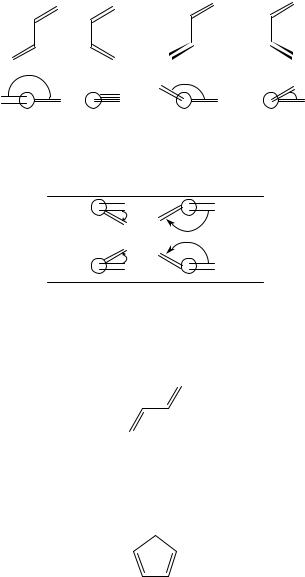
4. Conformation and chiroptical properties of dienes and polyenes |
113 |
θ |
|
θ |
|
|
|
θ |
|
|
|
θ |
|
|
|
|
|
s-trans |
s-cis |
transoid |
cisoid |
θ = 180° |
θ = 0° |
90° < θ <180° |
0° < θ < 90° |
|
|
SCHEME 1 |
|
Helicity |
cisoid |
transoid |
|
P |
|
|
θ > 0 |
|
|
|
|
M |
|
|
θ < 0 |
|
|
|
SCHEME 2
The possibility of delocalization of the electrons of the diene system across the formally bond between carbon atoms 2 and 3 forces the molecule to be planar, thus we have two limiting conformations6:
(1) The planar s-trans (e.g. 1,3-butadiene).
This is the most populated form of 1,3-butadiene, which at room temperature is present in about 99% abundance5,6. The characteristic absorption feature of this chromophore is the intense band at about 210 nm showing εmax larger than 20000. It has been unanimously6 assigned to the ! Ł 1Ag ! 1Bu transition of the C2h chromophore (see Appendix, Section V).
(2) The s-cis conformation (e.g. cyclopentadiene).
In this molecule the diene moiety assumes the C2v symmetry and the prominent feature of its near-UV absorption spectrum is the 240 nm band (εmax 3500), assigned6 to the same transition ! Ł , now characterized by 1A1 ! 1B2 symmetry in the C2v point group (see Appendix, Section V).
Actually, as demonstrated by Gross and Schnepp5, both the s-cis and the s-trans chromophores possess many other electronic transitions down to 140 nm. However, the near-UV part of the spectrum has been the most studied and only the lowest energy transition has been used as a structural probe to solve conformational and configurational

114 |
Piero Salvadori, Carlo Rosini and Lorenzo Di Bari |
problems. The present work will therefore be limited to the discussion of this band alone.
Both theoretical calculations and experimental investigations6 on model compounds indicate that the wavelength of the ! Ł (also indicated as N ! V1) transition is longest (around 250 nm) in the s-cis conformation, reaches a minimum for skewed forms (190 nm when ³ 90°), where conjugation is inhibited, and again increases (to 220 nm) for the s-trans structure. The oscillator strength, f, is highest in the s-trans and becomes much smaller in the s-cis and skewed conformations7.
Increasing the number of conjugated double bonds leads to a marked bathochromic shift and to a hyperchromic effect, as predicted by Woodward’s and Fieser’s rules8.
C. Chiral Dienes and the Origin of Optical Activity
The planar C2h and C2v geometries of the 1,3-butadiene moiety are achiral structures and obviously they cannot show optical activity (i.e. ORD and CD). This has, of course, a spectroscopic origin. The optical activity of a transition 0 ! i is determined by its Rotational Strength (R)1 defined as the scalar product
R D Imfm0i Ð m0ig D Imfh 0j j ii Ð h ijmj 0ig |
1 |
where m and m are the electric and magnetic dipole operators, respectively.
As shown in the Appendix (in Section V), in the C2h point group, the 1Ag ! 1Bu (i.e. the monoelectronic ! Ł excitation) possesses only an electric dipole moment, while in the C2v structure the electric and magnetic dipole moments, both non-vanishing, are orthogonal. In both cases the product in equation 1 leads to zero rotational strength.
Optical activity can arise only on reducing the molecular symmetry. This can be achieved in the following three ways.
1. Static distortion of the chromophore
In the tetrahydronaphthalene derivative 1, whose ORD spectrum is shown in Figure 1, the two conjugated double bonds are not coplanar9 and define a twist angle of about 17°. The point group is now C2 and the lowest ! Ł transition is 1A ! 1B, which is both electrically and magnetically allowed. The two moments are collinear and the transition acquires a non-vanishing rotational strength. This distortion, caused by a chemical constraint (e.g. the cycle in 1), is present in the molecule in its equilibrium configuration and can therefore be defined as static.
Me
(1)
2. Dynamic distortion of the chromophore
In molecules like 2, or 3, the 1,3-diene chromophore is planar. Formally, the presence of R differentiates the two vertical halves of the molecule, which becomes chiral10. The physical meaning of this differentiation is that it induces dissymmetric vibrations, which determine, in turn, a dynamic twist of the chromophore.
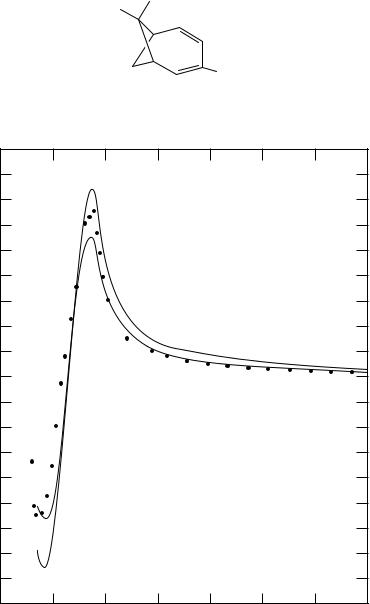
4. Conformation and chiroptical properties of dienes and polyenes |
115 |
R
(2)R = Me
(3)R = D
[α] × 10−3
18 |
|
|
|
|
|
|
|
16 |
|
|
|
|
|
|
|
14 |
|
|
|
|
|
|
|
12 |
|
|
|
|
|
|
|
10 |
|
|
|
|
|
|
|
8 |
|
|
|
|
|
|
|
6 |
|
|
|
|
|
|
|
4 |
|
|
|
|
|
|
|
2 |
|
|
|
|
|
|
|
0 |
|
|
|
|
|
|
|
−2 |
|
|
|
|
|
|
|
−4 |
|
|
|
|
|
|
|
−6 |
|
|
|
|
|
|
|
−8 |
|
|
|
|
|
|
|
−10 |
|
|
|
|
|
|
|
−12 |
|
|
|
|
|
|
|
−14 |
|
|
|
|
|
|
|
−16 |
|
|
|
|
|
|
|
−18 |
|
|
|
|
|
|
|
200 |
250 |
300 |
350 |
400 |
450 |
500 |
550 |
Wavelength (mµ)
FIGURE 1. ORD spectrum of (C)-trans-9-methyl-1,4,9,10-tetrahydronaphthalene, 1 (dots). The two lines are computational results with (dashed) or without (continuous line) correction for the solvent refractive index. Reprinted with permission from Reference 9. Copyright 1961 American Chemical Society
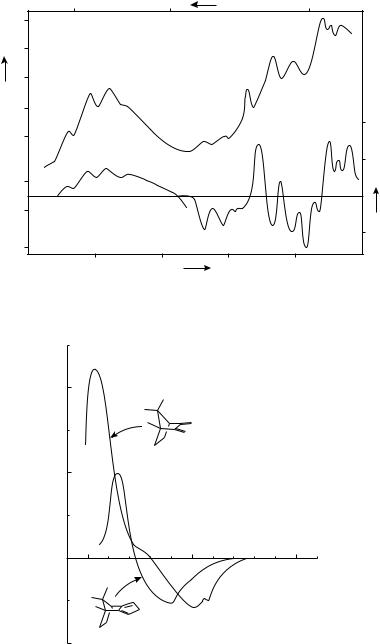
116 |
Piero Salvadori, Carlo Rosini and Lorenzo Di Bari |
|||
|
300 |
λ(nm) |
|
200 |
|
250 |
|
||
|
5 |
|
|
|
|
4 |
|
|
|
ε /103 |
3 |
|
|
|
|
|
|
|
|
|
2 |
|
|
|
|
|
|
|
+10 |
|
1 |
|
|
|
|
|
|
|
+5 |
|
+0.1 |
|
|
|
∆ε |
|
|
|
∆ε |
|
−0.1 |
|
|
|
|
|
|
|
|
|
|
|
|
−5 |
|
35 |
40 |
45 |
50 |
|
|
~ |
|
|
|
|
ν/103 cm−1 |
|
|
FIGURE 2. UV (upper curve) and CD (lower curve) spectra of 2. Reprinted with permission from Reference 10. Copyright 1983 American Chemical Society
2
4
1
∆ε
0 |
250 |
300nm |
200 |
5
−1
FIGURE 3. CD spectra of compounds 4 and 5. Reprinted from Reference 11, with kind permission from Elsevier Science Ltd, The Boulevard, Langford Lane, Kidlington 0X5 1 GB, UK

4. Conformation and chiroptical properties of dienes and polyenes |
117 |
The UV and CD spectra of 2 are reported in Figure 2.
3. External dissymmetric perturbation
In 4 and 5 the chromophore is planar and the optical activity arises from the lack of a vertical symmetry plane (i.e. that bisecting the diene moiety), owing to the presence of the C1 CH3 bond, which has no counterpart in the other half of the molecule11.
(4)(5)
Furthermore, whenever the 1,3-diene group is not embedded in a rigid structure, e.g. in 612 and 713, it assumes the most stable s-trans conformation, just as in the case of 1,3- butadiene. Again dissymmetrically disposed substituents perturb the ! Ł transition, which acquires some magnetic moment parallel to the electric one.
Me H
Me H
H Me
(6) |
(7) |
Figure 3 shows the CD spectrum of 4 and 5, while Figure 4 reports absorption and CD spectra of 7.
D. Intrinsically Chiral Dienes
As discussed above, the distortion of the 1,3-diene determines the lowering of symmetry of the chromophore from C2v to C2. The low-energy ! Ł transition thus acquires non-vanishing rotational strength and becomes optically active1,14. The methods proposed for interpreting the CD of intrinsically chiral dienes tend to attribute the most relevant role either to the distortion of the chromophore or to the perturbation arising from its environment. The two effects add up, sometimes acting in the same sense, sometimes conflicting. This makes it rather difficult to find a definite, general and simple relation between stereochemistry and optical activity for these compounds.
1. The diene chirality rule
The first correlation between the sign of the CD band allied to the 1A ! 1B transition and the molecular chirality was formulated just taking into account the lowering of symmetry of distorted dienes only9,15.
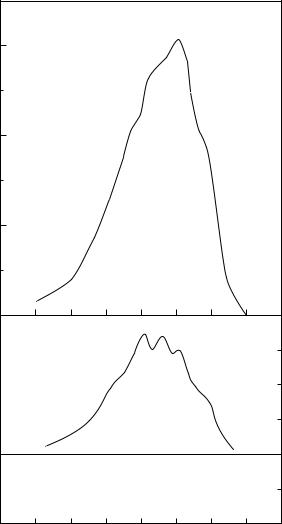
118 |
Piero Salvadori, Carlo Rosini and Lorenzo Di Bari |
3
2
10 −4
• ε
1
+3
+1
0 |
∆ε |
−1
190 |
210 |
230 |
250 |
|
|
λ(nm) |
|
FIGURE 4. UV (upper curve) and CD (lower curve) spectra of 7 (continuous line). Reprinted from Reference 13, with kind permission from Elsevier Science Ltd, The Boulevard, Langford Lane, Kidlingten OX5 1 GB, UK
The diene chirality rule (hereafter referred to as DR) constitutes a simple tool for correlating the sign of the lowest energy ! Ł transition (1A ! 1B in C2 symmetry) of the distorted diene to the chirality (left or right-handed) of the chromophore. The validity of this rule is based on the assumption that the CD of the distorted chromophore is determined by its intrinsic helicity alone and that external dissymmetric perturbations have only minor effects on the optical activity.
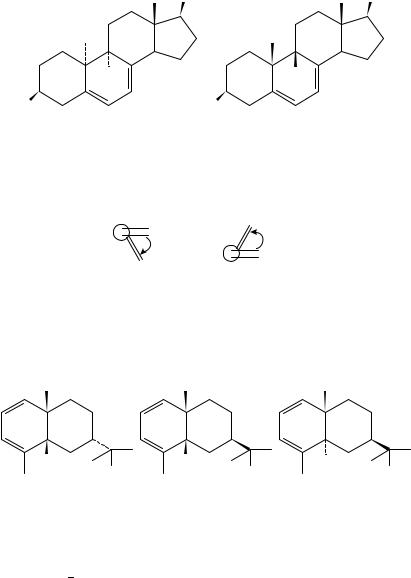
4. Conformation and chiroptical properties of dienes and polyenes |
119 |
This point of view finds its justification in the following observations. Compounds 8 (pyrocalciferol) and 9 (isopyrocalciferol), having opposite absolute configurations of the stereogenic centres near the dienes, show 1A ! 1B Cotton effects at about 275 nm of the same sign and intensity. The reason for this is that only the twist of the chromophore determines the optical activity; in fact the diene moieties are distorted in the same sense in 8 and 9, as found by X-ray diffraction16.
C9 H17 |
C9 H17 |
H |
H |
HO |
HO |
(8) |
(9) |
∆ε = +20 (275 nm) |
∆ε = +23 (272 nm) |
The correlation shown in Scheme 3 has been formulated between the sense of twist and the sign of the 1A ! 1B Cotton effect.
θ >0° |
θ <0° |
|
P chirality |
M chirality |
positive Cotton effect |
negative Cotton effect |
SCHEME 3
The diene rule has had much importance in the interpretation of the optical activity of distorted dienes, as in the case of occidentalol, epi-occidentalol and trans-occidentalol, 10, 11 and 12, respectively17.
H |
H |
|
H |
|
OH |
OH |
OH |
(10) |
(11) |
|
(12) |
∆ε = − 2.2 |
∆ε = + 8.4 |
|
∆ε = − 6.4 |
M |
P |
|
M |
It has been successfully based on various calculations at different degrees of sophistication7,18 26.
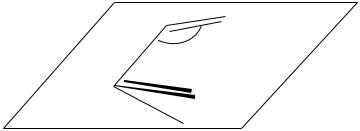
120 |
Piero Salvadori, Carlo Rosini and Lorenzo Di Bari |
a. Theoretical models justifying the diene rule. The rotational strength (R) allied to the longest-wavelength ! Ł transition in twisted butadiene can be calculated according to two simple models: the former uses a molecular orbital approach1a,1c,22, the latter treats the diene as a pair of interacting double bonds, in a coupled-oscillator framework14. A schematic derivation of the relevant equations is given in the Appendix (Section V). It is interesting to note that these totally independent approaches yield the same result:
R |
|
Ł |
/ |
sin2 |
ˇ sin |
2 |
|
|
|
|
|
according to the definition of the internal angles given in Scheme 4.
β
 θ
θ
SCHEME 4
This means that R is proportional to the sine of the dihedral angle between the two double bonds, with the positive sense defined in Scheme 2. Such a dependence confirms the diene rule because positive angles define positive helicity and imply positive R.
We note that this result is confirmed by the derivation of the rotational strength for a general C2 chromophore, due to Hug and Wagniere`27. They showed, using a pure symmetry token, that the longer-wavelength B transition follows the DR, whereas the higher-energy A transition has opposite sign. This will be shown to have relevant consequences in the case of carotenoids.
The sin proportionality of R Ł obtained here with two independent, however sim-
plistic, approaches allows us to extend the DR, originally formulated for the cisoid dienes, even to the transoid chromophores, as shown in Scheme 5.
Actually, it is very important to note that this ‘general diene rule’, covering s-cis and s-trans systems, has been formulated on the basis of a coupled oscillator model and by means of a simple Huckel¨ MO calculation. More sophisticated MO treatments of the 1,3-butadiene moiety afford contrasting results: while the largest part of the calculations gives positive rotational strengths for all the positive values of , in some cases (e.g. CNDO/S23 and CNDO/2 calculations23,28) anti-DR behaviours (negative R for positive) have been reported. The accuracy of the wavefunctions obtained for twist angles around 90° is however questionable, which suggests that reliable results are only for 0° < < 45° and 135° < < 180°29 .
The problem of interpreting the chiroptical properties of highly distorted dienes remains, however, a different question (see Section II.D.3 below).
2. Allylic axial chirality rule
About 10 years after the first formulation of DR and 5 years after its theoretical justification by Charney, some contradictory results emerged which make its validity questionable.
One of the major problems was the case of the cisoid heteroannular dienes30,31, which present a CD band at about 240 nm with a sign opposite to that predicted on the basis of the diene helicity by means of the DR.
